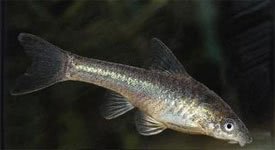
 Magyarul / Hungarian
Magyarul / Hungarian


- Scientific name: Macrotocinclus affinis
- Synonyms: Otocinclus affinis
- Common name: Midget Catfish, Midget Sucker Catfish
- Group: Catfishes
- Habitat: South America, Brazil, Amazon river basin
- Size: 4 cm
- Biotope: Heavily vegetated rivers of Brazil and the Amazon watershed.
- Social behavior: Társas, rajokban él. Az aljzat közelében úszik.
- Diet: Vegetarian food, algae, small live, Brine Shrimp, insect larvae, vegetables, lettuce, peas, spinach, tablets
- Breeding: Quite easy
- Tank: Minimum 40 litres
- Population: 4-5 fishes for 50 litres
- Decoration: The tank should be well-planted with thickets for hiding places.
- Temperature: 22-25°C
- pH: 6-7,2.
- Hardness: 5,6-11,2 NK°
- Lifespan: 3-5 years
Description: An elongated fish with a flat belly and a slightly curved back. The eyes are set on the sides and are visible when looked at from the bottom. The mouth faces down as would be expected from a sucker type fish. This fish has no barbels or adipose fin. The pectoral, pelvic, dorsal, and anal fins are clear and the tail fin is striped .The females are more rounded or robust.
Not one of the most eye catching fish the otos most distinct feature is the brown stripe running down the sides. The main body color is a dull gray green color. Some species the body is more yellow and is often called the golden oto. The belly is white with a hint of yellow. The back is dark.
The oto can be difficult to acclimate to the home aquarium, but provided the water conditions are correct and there is some green food they should be OK. The set up should be well established with a sand or gravel substrate, Densely planted with live plants or an established algae growth is essential. While they will take flake food and sinking pellets the natural greens are needed to provide proper health. If no algae is available they will eat the softer bodied plants. Provide good water circulation and filtering. Best keep in groups the actual number will vary upon tank size. Fine with most fish except the larger predatory species.
It would have to be classified as difficult. They have been bred in captivity but it seems to be a sporadic occurrence. Similar to the armored catfish the eggs are laid on the leaves of plants or on the tank glass. No care is given once they are laid. The eggs hatch in about two days and three days later the fry are free swimming. Extremely small and delicate they must be fed newly hatched brine shrimp, crushed vegetable flake food and even boiled spinach.




























